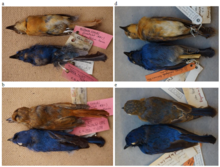Rück's blue flycatcher(Cyornis ruckii) is apasserinebird in the Old World flycatcher familyMuscicapidae.It is known from only four specimens and isendemicto a small area in northeastSumatra,Indonesia, inhabitingprimary lowland forest.Although all specimens share common characteristics, such as a blackbill,browniris,and black feet, two of the collected specimens show some physical discrepancy with the other two. They were initially described asCyornis vanheystibefore being accepted as specimens ofC. ruckii.Rück's blue flycatcher has also been compared to other species ofCyornis.
| Rück's blue flycatcher | |
|---|---|

| |
| Left side (a and b): Top specimen is an adult female, bottom is an adult male, both described by Oustalet.Right side (d and e): Top specimen is an immature male, bottom is an adult male, both described by Robinson & Kloss. | |
| Scientific classification | |
| Domain: | Eukaryota |
| Kingdom: | Animalia |
| Phylum: | Chordata |
| Class: | Aves |
| Order: | Passeriformes |
| Family: | Muscicapidae |
| Genus: | Cyornis |
| Species: | C. ruckii
|
| Binomial name | |
| Cyornis ruckii (Oustalet,1881)
| |

| |
| Distribution ofC. Ruckii[1] | |
| Synonyms | |
The species is listed as "Critically Endangered"by theInternational Union for Conservation of Natureas it has not been recorded since 1918. It has been protected by Indonesian law since 1972. It also might have been affected by the2004 Indian Ocean tsunami.
Taxonomy
editRück's blue flycatcher was first described by the FrenchzoologistÉmile Oustaletin 1881, who studied two specimens (adult male and female) in theFrench National Museum of Natural History.The specimens were sent by Monsieur Rück from a trading port in modern-dayMalacca,Malaysia, in 1880. Oustalet named the species after Rück and gave it thebinomial nameCyornis ruckii.The binomial is sometimes emended to theCyornis rueckii,but this is regarded as an incorrect spelling.[3]: 14 [4]Othercommon namesfor the species include Rueck's blue flycatcher and Rueck's niltava.[5]
A further two specimens (adult male and immature male) were collected by A. van Heyst in 1917 and 1918 nearMedan,where they were subsequently described as a new species (Cyornis vanheysti) by the British zoologistsHerbert RobinsonandCecil Klossin 1919. They also noted their similarity to the specimens described by Oustalet, eventually synonymizingC. vanheystiwithC. ruckii.The specimens reside in theAmerican Museum of Natural History.[3]: 14
The specimens have also been considered as being an aberrant form of thepale blue flycatcher(Cyornis unicolor). However, comparisons show that the pale blue flycatcher is different in both color andtopography.[3][4][6]Rück's blue flycatcher ismonotypic.[7]
Description
editRück's blue flycatcher is 17 cm (6.7 in) in length, with a blackbill,brownirisand black feet. Differences between the specimens described by Oustalet and Robinson & Kloss exist. In the Oustalet specimens, the male has dark blue plumage, a blue belly, and a shining blue rump. There is also a small amount of grey coloring on disrupted feathers around the legs. The female has rufous-brown plumage, strong rufouslores,orange-rufous breast and a whitish belly. In the Robinson & Kloss specimens, the immature male has brown-spotted buff plumage with a rufous breast and a whitish center on underparts. The adult male shows some discrepancy with the adult male specimen described by Oustalet; the belly and tail coverts are whitish grey, while the flanks are bluish grey. Additionally, the Robinson & Kloss specimens have slightly larger bills. These differences could be caused byindividual variationor due to the specimens being of differentsubspecies.[3]: 15 [4][6]
Distribution and habitat
editRück's blue flycatcher isendemictoSumatra,Indonesia, aroundMedan,and presumably has a low population density. The specimens collected by Rück were fromprimarylowland forest, while the ones collected by van Heyst are thought to be from exploited forest,[3]which might show possible tolerance against habitat degradation,[4][8]: 46 [9]: 23 although this is disputed.[note 1]
Conservation
editLast recorded in 1918, and due to ongoing habitat loss, poor surveying, and its small population and limited range, Rück's blue flycatcher is evaluated as "Critically Endangered"on theIUCN Red List.It is listed in Appendix II ofCITESand has been protected under Indonesian law since 1972.[1][3][4]In 2013 and 2014, observations inJambi,Sumatra, revealed a pair of unidentified flycatchers that resembled Rück's blue flycatcher, but the possibility of them beingwhite-tailed flycatchers(Cyornis concretus) could not be eliminated.[6]Rück's blue flycatcher might have been affected by the2004 Indian Ocean tsunami,[10]: 19 and is also predicted to be extinct with 80% confidence.[11]: 759
Notes
editReferences
edit- ^abcBirdLife International (2016)."Cyornis ruckii".IUCN Red List of Threatened Species.2016:e.T22709502A94212416.doi:10.2305/IUCN.UK.2016-3.RLTS.T22709502A94212416.en.Retrieved19 November2021.
- ^"Appendices | CITES".cites.org.Retrieved14 January2022.
- ^abcdefgCollar, Nigel (2020)."Rück's Blue-flycatcher Cyornis ruckii: the evidence revisited".KUKILA.23:14–18.ISSN0216-9223.
- ^abcdeClement, Peter; Sharpe, Chris (4 March 2020). Billerman, Shawn M.; Keeney, Brooke K.; Rodewald, Paul G.; Schulenberg, Thomas S. (eds.)."Rück's Blue Flycatcher (Cyornis ruckii)".Birds of the World.Cornell Lab of Ornithology.doi:10.2173/bow.rubfly1.01.S2CID243357398.Retrieved6 December2021.
- ^"Cyornis ruckii (Rueck's Blue-Flycatcher)".Avibase.Retrieved27 November2021.
- ^abcAssiddiqi, Zulqarnain; Balen, Sebastianus van; Collar, Nigel J. (2020)."Mystery flycatchers in Sumatra - Rück's Blue-flycatcher or White-tailed Flycatcher?".KUKILA.23:19–26.ISSN0216-9223.
- ^"Chats, Old World flycatchers – IOC World Bird List".Retrieved6 December2021.
- ^Butchart, S. H. M.; Collar, N. J. (2005). "Lost" and poorly known birds: top targets for birders in Asia ".Birding Asia.3:41–49.
- ^Butchart, S. H. M.; Stattersfield, A. F.; Brooks, T. M."Going or gone: defining 'Possibly Extinct' species to give a truer picture of recent extinctions".Bulletin of the British Ornithologists' Club:7–24.
- ^Crosby, Michael J. (1 November 2005)."Impacts of the Indian Ocean tsunami on birds and their habitats".Biodiversity.6(3): 14–19.doi:10.1080/14888386.2005.9712770.ISSN1488-8386.S2CID128550950.
- ^Collen, Ben; Purvis, Andy; Mace, Georgina M. (2010)."When is a species really extinct? Testing extinction inference from a sighting record to inform conservation assessment".Diversity and Distributions.16(5): 755–764.doi:10.1111/j.1472-4642.2010.00689.x.ISSN1472-4642.
